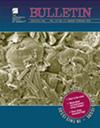Investigating weathering signatures in terrestrial muds: Can climatic signatures be separated from provenance?
IF 3.9
1区 地球科学
Q1 GEOSCIENCES, MULTIDISCIPLINARY
引用次数: 0
Abstract
Siliciclastic muds (clay- and silt-sized sediment) concentrate physical and chemical weathering products. However, both rock composition and climate can affect the mineralogy and geochemistry of these sediments. We quantitatively assessed the influence of provenance and climate on muds collected from end-member climates to test, which, if any, of these potential weathering signatures are indicative of climate in fine-grained, fluvial sediments. Granulometry, mineralogy, and geochemistry of the studied muds indicated that provenance and mineral sorting hinder interpretation of (paleo)climate signals. These issues also affect chemical index of alteration (CIA) values, as well as mafic-felsic-weathering (MFW), Al2O3−(CaO* + Na2O)−K2O (A-CN-K), and Al2O3−(CaO* + Na2O + K2O)−(FeOT + MgO) (A-CNK-FM) ternary plots, decreasing their utility as paleoclimate proxies. CaO content is heavily weighted within the calculations, resulting in even felsic-sourced sediment commonly plotting as mafic owing to the relative enrichment in CaO from preferential sorting of Ca-rich minerals into the mud-sized fraction during transport. These results cast doubt on the indiscriminate use of CIA values and ternary plots for interpreting chemical weathering and paleoclimate within muds, particularly from glacial systems. Most notably, the positive correlations between CIA and climatic parameters (mean annual temperature and mean annual precipitation) diminished when sediments that had formed in nonglacial settings were filtered out from the data sets. This implies that CIA may only be applicable when used in nonglacial systems in which the composition of the primary source material is well constrained—such as soil/paleosol profiles. Within this end-member climate data set, CIA was only useful in discriminating hot-humid climates.研究陆相泥的风化特征:气候特征能与物源分离吗?
硅塑性泥(粘土和粉砂状沉积物)是物理和化学风化产物的浓缩物。然而,岩石组成和气候都会影响这些沉积物的矿物学和地球化学。我们定量地评估了物源和气候对从端元气候中收集的泥浆的影响,以测试这些潜在的风化特征中,如果有的话,哪些是细粒度河流沉积物中气候的指示。所研究的泥的粒度、矿物学和地球化学表明,物源和矿物分选阻碍了(古)气候信号的解释。这些问题还影响了化学蚀变指数(CIA)值,以及基性-长质-风化(MFW)、Al2O3 - (CaO* + Na2O) - K2O (A-CN-K)和Al2O3 - (CaO* + Na2O + K2O) - (FeOT + MgO) (A-CNK-FM)三元图,降低了它们作为古气候指标的效用。在计算中,CaO含量的权重很大,这导致即使是长质沉积物也通常被标为基性,这是由于在运移过程中,富钙矿物优先分选到泥质组分中,CaO相对富集。这些结果对不加区分地使用CIA值和三元图来解释泥中的化学风化和古气候,特别是冰川系统中的化学风化和古气候提出了质疑。最值得注意的是,当从数据集中过滤掉在非冰川环境中形成的沉积物时,CIA与气候参数(年平均温度和年平均降水)之间的正相关性减弱。这意味着CIA可能只适用于非冰川系统,其中主要来源材料的组成受到很好的限制,例如土壤/古土壤剖面。在这个末端成员气候数据集中,CIA仅在区分湿热气候方面有用。
本文章由计算机程序翻译,如有差异,请以英文原文为准。
求助全文
约1分钟内获得全文
求助全文
来源期刊

Geological Society of America Bulletin
地学-地球科学综合
CiteScore
9.30
自引率
8.20%
发文量
159
审稿时长
4-8 weeks
期刊介绍:
The GSA Bulletin is the Society''s premier scholarly journal, published continuously since 1890. Its first editor was William John (WJ) McGee, who was responsible for establishing much of its original style and format. Fully refereed, each bimonthly issue includes 16-20 papers focusing on the most definitive, timely, and classic-style research in all earth-science disciplines. The Bulletin welcomes most contributions that are data-rich, mature studies of broad interest (i.e., of interest to more than one sub-discipline of earth science) and of lasting, archival quality. These include (but are not limited to) studies related to tectonics, structural geology, geochemistry, geophysics, hydrogeology, marine geology, paleoclimatology, planetary geology, quaternary geology/geomorphology, sedimentary geology, stratigraphy, and volcanology. The journal is committed to further developing both the scope of its content and its international profile so that it publishes the most current earth science research that will be of wide interest to geoscientists.
 求助内容:
求助内容: 应助结果提醒方式:
应助结果提醒方式:


